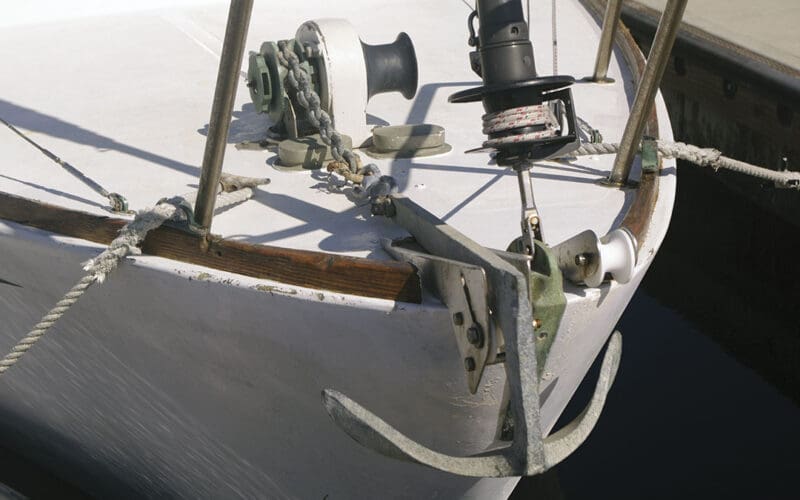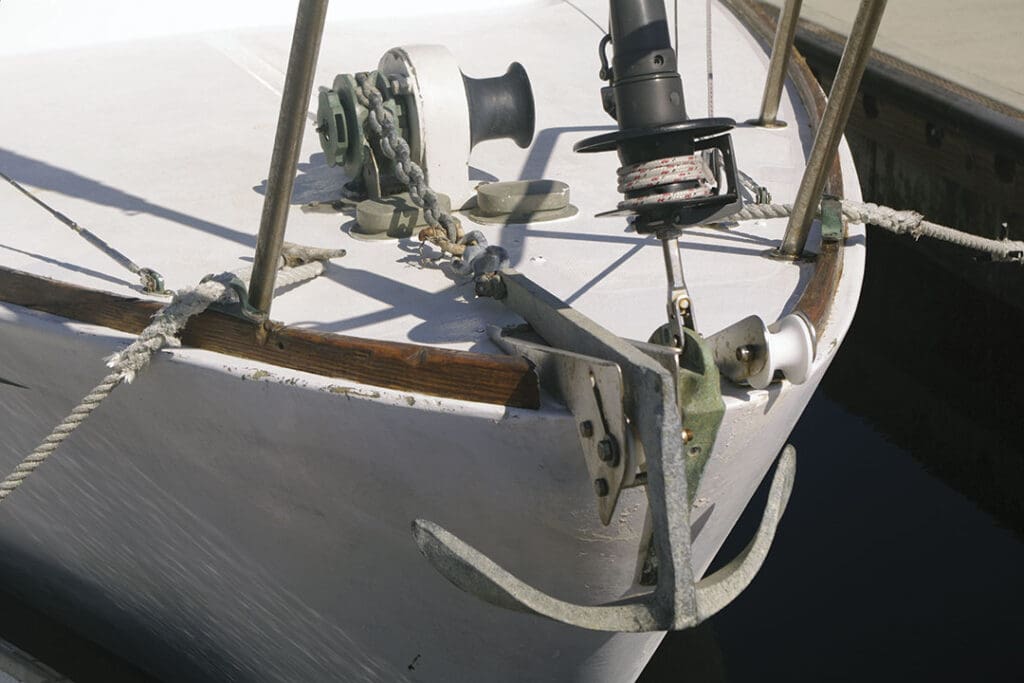
Every ocean-going vessel needs to have a dependable anchor windlass to take the hard work out of deploying and retrieving the anchor. We can choose between a traditional manual windlass or a modern electric model capable of handling extreme stresses in every type of anchoring situation.
Despite what you may have heard about manual windlasses, operating one does not require super-human powers. Quite to the contrary, a manual windlass is designed to make the job of raising the anchor easy, eliminating the strain you would otherwise endure by pulling up the hook and chain with your bare hands.
For many of us, especially those on very large yachts with heavy anchors and long lengths of chain, the convenience of an electric windlass makes a voyage all the more pleasant, taking the worry out of the possibility of having to negotiate with difficult, rocky terrain by hand.
Manual Windlasses
If any single object on a cruising vessel embodies energy independence more than anything else, it is a manual windlass. Strong and dependable, it is emblematic of rugged, die-hard, individualistic cruising sailors who insist on being in constant physical control of their ships, viscerally in tune with their watery, off-grid environs.
Despite what you may have heard about manual windlasses, operating one does not require super-human powers. Quite to the contrary, a manual windlass is designed to make the job of raising the anchor easy, eliminating the strain you would otherwise endure by pulling up the hook and chain with your bare hands.
The object of these machines is to offer a good measure of mechanical advantage, which means lots of cranking and a nice, little workout, but well within the physical limits of an adult of average strength. And when compared to electric windlasses, the manual device can claim full allegiance to the green cause: it uses not a single milliamp to operate.
Horizontal manual windlasses are designed to reduce the job of weighing anchor to a straightforward, routine procedure without the aid of a hydraulic pump or an electric motor. Internal reduction gearing makes it possible for an adult of average strength to pull, depending on the model, up to several hundred pounds of ground tackle in a stiff breeze. With rare exception, the manual windlass mounted on the bow of a cruising sailboat has a horizontal drive shaft with a wildcat and a rope capstan, each mounted on either side of the unit’s gear box. Virtually all of these units have the wildcat mounted on the starboard side directly aft of the bow roller, permitting the chain to make a solid connection with teeth of the wildcat.
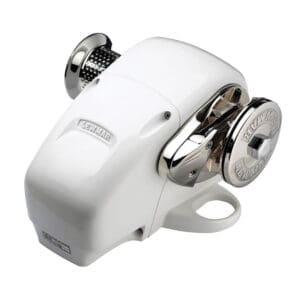
The Simpson-Lawrence Legacy
When Simpson Lawrence sold out to Lewmar in 2000, one of the most lamentable casualties of the transaction was the complete closure of the Simpson Lawrence line of manual windlasses. However, parts for the 510, 555 and Anchorman windlasses can be found on the Internet, and here and there you might even find a brand-new 510 or 555 still in the original box. Fortunately, there is a thriving cottage industry dedicated to producing replacement parts for the old Simpson Lawrence machines.
If you take a stroll through any North American cruiser marina today, you will see a high percentage of the offshore-bound vessels are still equipped with a 555 windlass, the enduring standard for the various knockoffs of this device. The 555 is designed to convert both forward and backward motion of the windlass handle into a one-way rotation of the horizontal drive shaft, to which both the capstan and wildcat are connected. The double action turns spur reduction gears, two of which are spring loaded to alternate in and out of the meshed sequence, keeping the drive shaft moving in its single direction. The 555 features a high-speed gear with a handle fitting on the port side and a low-speed gear fitting on the starboard side. Having separate handle fittings for the two gears rather than a selector switch ensures simpler operation, lighter construction (40 pounds) and fewer components to fail under extreme conditions.
The 25-pound Hyspeed 510 is decidedly not a miniature of its big brother, the 555. The 510’s one-speed drive system, which also has a mechanical advantage of 12:1, is comprised of two bicycle chains and two sprockets mounted in opposite directions to permit one-way rotation of the drive shaft. Unlike the 555, which is lubricated internally with grease, the 510’s chain and sprockets require a bath of heavy gear oil to keep them from rusting and binding up. The one irksome annual chore with this machine is uninstalling the unit from the foredeck, removing the clutch and cover plate, and inspecting the gear oil. Milky sludge indicates water intrusion. If the gasket is shot, you will have to cut a new one from a sheet of cork or thick paper gasket material, taking care not to break the fragile, narrow piece while you poke holes for the screws. After reassembling the unit, remove the bronze NPT plug from the base of the port side and fill with gear oil to the top of the thread. The cone clutch operates in the same manner as that of the 555, and both clutches require occasional lubrication through the grease nipple to keep them operating smoothly.
New Manual Windlasses
Several American and European manufacturers continue to produce manual windlasses along with their electric or hydraulic models. One of the most frequently mentioned in dockside conversation is the Lofrans Royal, built in Monza, Italy. Available in anodized aluminum or white enamel and very reasonably priced, this one-speed, double-action horizontal windlass uses a bevel gear drive system to pull up to 430 pounds and is recommended for vessels ranging from 26 to 39 feet LOA. The Royal weighs 22 pounds, slightly less than the SL 510, and its hot-forged bronze wildcat accepts ¼-inch, 5/16 and 3/8 high-test, proof coil and BBB chain.
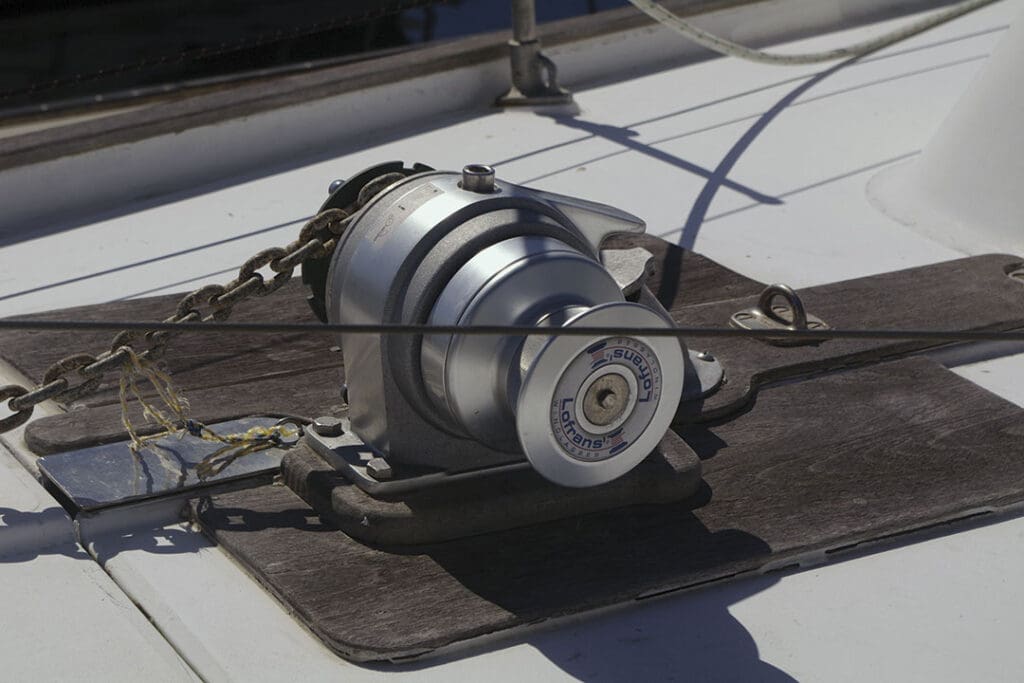
A windlass appearing almost identical to the Lofrans Royal is the Ursus horizontal windlass, produced by Vetus of the UK. Vetus supplies a wide range of equipment to the nautical industry, including engines, plumbing fixtures, bow thrusters and fuel tanks. Built with roughly the same dimensions and mechanical operating system as the Lofrans Royal, the Ursus sells for roughly a grand and will probably last as long as the Lofrans. The wildcat accepts 5/16 proof coil and BBB chain. The company offers little in the way of construction details, so it is advisable to find an Ursus owner, inspect the windlass and read the product literature included with the unit before deciding whether to make a purchase.
R.C. Plath of Portland, Ore., prides itself in high-quality precision metal spinning, which contributes to the continuing success of its simply designed and constructed manual windlass. Model 9A is cast in high-tensile, marine-grade aluminum, yielding a strong yet light machine based on the heavier bronze Model 9B. The Model 9A weighs in at 28 pounds with combination capstan and wildcat, and the Model 9B, also available in chrome plate, with the same configuration, weighs a comparably hefty 45 pounds, which is still only five pounds more than the SL 555. Though R.C. Plath does not publish pull maximums for its windlasses, both the 9A and 9B are known to handle up to 800 pounds, and they have served well for many years on the decks of sailing vessels in excess of 35 feet LOA. The double-acting horizontal system is based on a gear drive similar to the SL 555 and therefore can last for decades with little servicing. Both the 9A and 9B accept ¼, 5/16 and 3/8 BBB chain and feature a cone clutch to hold the wildcat in place while retrieving the anchor.
Also on the list of manual windlasses is the Muir Easyweigh 500 vertical windlass, which comes in several options. You can choose a pure chain gypsy set-up, a chain gypsy with rope capstan or either of the two with or without a rope hawser. Similar to the SL Anchorman, the Easyweigh 500 is operated with a standard winch handle, which means you can increase leverage simply by using a longer handle.
Electric Windlasses
A combination of factors continues to feed the growing popularity of electric windlasses on modern cruising boats. Bigger vessels, bigger battery banks, an aging boater population and an ongoing trend away from the analog life toward a push button/touch screen lifestyle have conspired to make the electric windlass de rigeur on modern, high-tech cruising yachts measuring as little as 25 feet.
The latest Defender and West Marine catalogs no longer carry manual windlasses, now listing only the electric variety, although some small to mid-sized electric windlasses do include manual override capability.
If you are outfitting a large yacht, between roughly 45 to 60 feet on deck, an electric windlass is probably the best choice. For very large passenger vessels, a hydraulic system, such as the series built by AI Crane, is the obvious choice but outside the range of a typical, cruising vessel with only two to four crew members.
Just like manual windlasses, electric windlasses come in two species: vertical and horizontal. Vertical windlasses generally occupy less space than a wider horizontal windlass, but on a large yacht, the main difference essentially boils down to the owner’s preference. Both types are available, from diminutive models for small boats to large, hydraulic systems for yachts of much greater size and displacement.
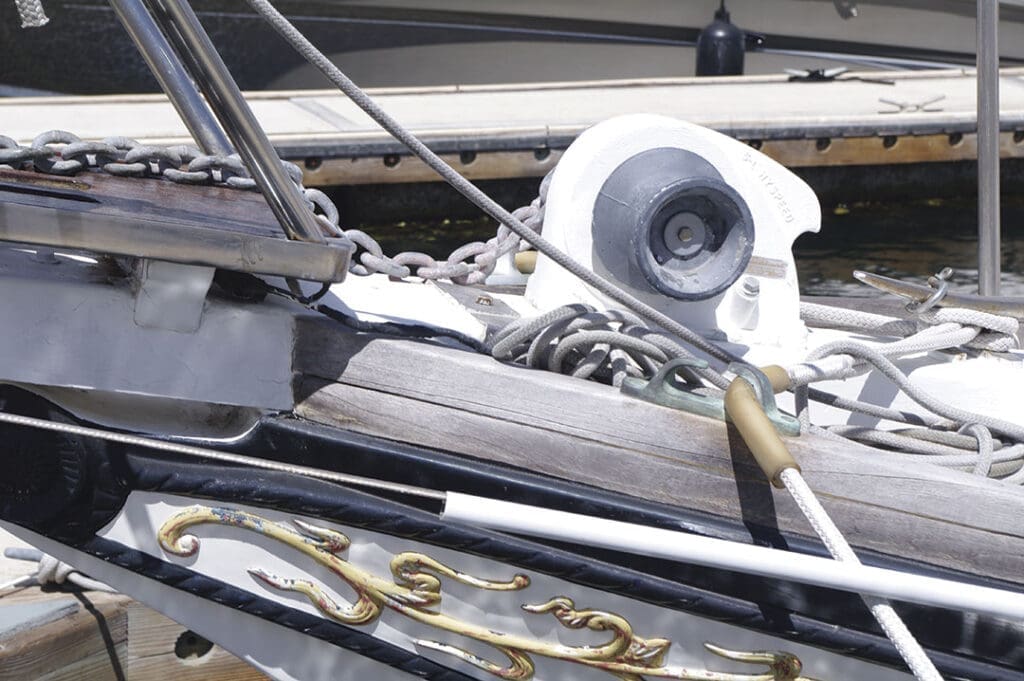
Horizontal
Many cruisers prefer the profile of a horizontal electric windlass, dividing the wildcat and rope capstan to either side of the motor housing. Some units divide the wildcat and capstan yet have the motor mounted below the deck. Ideal and Lofrans offer high-quality horizontal electric windlasses for mid-range cruising yachts, and both offer manual override. Very large yachts, measuring well over 70 feet, also use horizontal windlasses, such as those from Ideal Windlass.
Lewmar horizontal electric windlasses are generally designed for small to medium-sized boats and are intended for ¼-inch to 5/16-inch chain with ½-inch nylon rode, the perfect package for weekend fishing trips to local coastal islands. However, the windlasses are not designed for total immersion in breaking head seas, or for long exposure to the hot, humid conditions prevalent in tropical cruising.
Vertical
Most of the electric windlasses being sold today are of the vertical type. They are less complicated to manufacture, take up less deck space and are easier to operate. A vertical combination of drum and wildcat, available on large models, allows you to move from nylon rode to chain much more easily than by having to switch from one side of the windlass to the other.
Also, with the motor safely below deck, a vertical windlass is less exposed to the elements than an above-deck motor. Another feature of vertical windlasses is their manual override capability. Lewmar is known for its winch handle hole in the end cap at the top of the windlass, allowing manual operation. Maxwell’s vertical machines have a slot in the top cap specially designed for manual operation.
Some of the most popular vertical windlasses in their class are Lewmar’s V and CPX series and Maxwell’s RC and VWC series, not only because of their competitive prices but also their reputation for durability and ease of use. The profile of the Lewmar V series wildcat-only windlasses is so compact they look like small foredeck ornaments. Sleek and understated, the Lewmar V belies its pulling power, ranging from 1,000 pounds for the V1 wildcat to 3,190 pounds for the V5 wildcat/drum combination.
Maxwell offers several low-profile, capstan-only units in its VWC series. Known for their elegant sculpted appearance, the VWC series windlasses feature a built-in hawse pipe and chain stripper. Both the RC and WVC models include a reversing solenoid, circuit breaker panel, and in case of power loss or mechanical failure, an emergency handle for manual override.
The windlass we choose for our vessel will have an outsized influence on the success of future voyages. n

